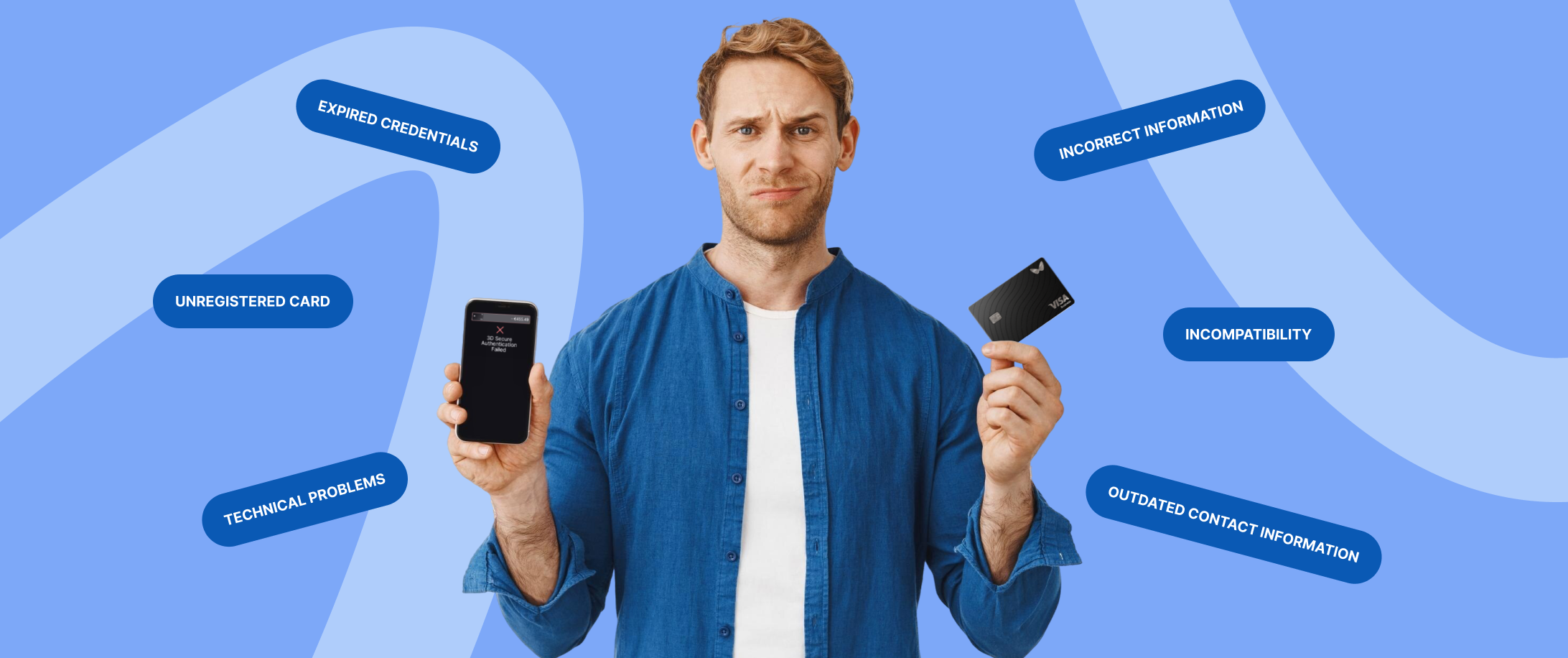Online shopping has become an essential part of modern life, but the growth of digital payments has raised concerns about security for consumers and businesses alike. 3D Secure (3DS) adds an extra layer of protection by verifying the identity of the cardholder during online transactions. Despite its effectiveness in preventing fraud, authentication failures can disrupt purchases and create challenges for both customers and merchants. Understanding why these issues occur and how to address them is important for smoother, safer online transactions.
3D Secure authentication explained
3D Secure, commonly known as 3DS, is a security protocol created to provide additional protection for online card transactions. Originally introduced by Visa under the name “Verified by Visa,” it has since been adopted by Mastercard (SecureCode), American Express (SafeKey), and other major payment networks. The purpose of 3DS is to ensure that the person making an online purchase is the legitimate cardholder, preventing fraudulent transactions even if card details are stolen.
The “3D” refers to the three domains involved in the process:
- The Issuer Domain, which is the cardholder’s bank responsible for verifying identity.
- The Acquirer Domain, which represents the business’s acquiring bank processing the transaction.
- The Interoperability Domain, which acts as the communication framework linking these two financial institutions.
When a transaction is initiated, the system redirects the customer to an authentication page managed by their financial institution. This step often involves entering a one-time passcode (OTP), providing biometric verification, or answering security questions. If the verification is successful, the transaction proceeds as usual. If not, the transaction is declined, protecting the cardholder and merchant from potential fraud.
3DS also helps businesses meet regulatory compliance requirements, such as the EU’s Strong Customer Authentication (SCA) rules under PSD2. By balancing security and convenience, 3DS has become an important part of the global e-commerce ecosystem.
How does 3D Secure authentication work?
Knowing how 3DS works makes it easier to see why it’s important for online payment security. Here’s a simple breakdown of how the process works:
- Transaction initiation. The customer begins an online purchase by entering payment details correctly on the main payment page of the merchant’s website.
- Authentication request. The merchant’s bank sends a request to the cardholder’s bank to verify the transaction.
- Redirection or embedded prompt. The cardholder is prompted to verify the identity, either through a separate authentication page or directly within the checkout page.
- Verification. The commercial institution requests proof of the customer’s identity, which could involve entering an OTP, using biometric customer data, or providing a PIN. At this stage, the customer enters the required authentication information to confirm their identity. These steps guarantee secure full authentication of the cardholder before the transaction proceeds.
- Approval or decline. If the authentication is successful, the card provider approves the transaction, and the payment is processed. The customer then receives an order confirmation message, signaling that the purchase has been successfully completed. If the payer authentication fails, the operation is declined, and the customer must retry or seek assistance.
In addition to traditional methods, Wallester offers an alternative way to make the verification process quicker through in-app authentication. This feature allows users to confirm online payments directly within the Wallester mobile app, avoiding the need for SMS or email confirmations. All actions take place within one platform, making transactions faster and more secure through advanced data protection protocols.
Modern versions like 3DS 2.0 improve this process by using real-time data to assess the risk of each transaction. Low-risk transactions can often skip additional verification steps. Wallester also supports the 3DS Whitelist feature, which automates authentication for trusted websites. This feature is particularly valuable for resellers and advertisers who make frequent online payments. By adding reliable sites to the whitelist, users can bypass repetitive authentication steps, maintaining high security while improving transaction efficiency.
Further Reading: What Is 3D Secure Authentication and How Does it Work?
Do I need to activate 3D Secure authentication for online purchases?
For many modern cards, 3DS is already set up automatically, allowing cardholders to benefit from the added security without any extra steps. However, in some cases, financial institutions may require you to activate it manually, especially if you’re using an older card or if your bank operates in regions where the protocol is less common. If your card doesn’t support 3DS, certain transactions with merchants that use the protocol may not go through, which can be inconvenient.
Activating 3D Secure is a straightforward process. Typically, you’ll log into your bank’s online portal or app, where you’ll find the option to register for 3DS under the card management section. The process might involve linking your mobile phone number to receive OTPs or setting up a PIN for verification purposes. Once completed, your card will be ready for safer online transactions, and the entire process usually takes just a few minutes.
If you often shop online, activating 3DS is important, as many merchants rely on it for secure credit card payments. It’s a simple way to protect your card from unauthorized use while guaranteeing your transactions go through without issues.
Benefits of 3D Secure authentication
The implementation of the protocol offers numerous advantages for both consumers and merchants, improving the security of online payments while addressing common risks associated with digital transactions. Here’s a closer look at the key benefits:
- Fraud protection
One of the most significant advantages of 3DS is its ability to reduce fraud. By verifying the identity of the cardholder during a transaction, it adds an additional layer of protection against unauthorized use. Even if a fraudster manages to obtain card details, the additional verification step makes it difficult to complete a purchase. This is especially important in an era where data breaches and phishing attacks have become increasingly common.
- Chargeback reduction
For merchants, chargebacks are a drain on time and resources. The protocol helps minimize these disputes by validating the authenticity of transactions upfront. When customers are verified during the payment process, the chances of disputes over unauthorized purchases decrease significantly. This saves merchants’ money and strengthens their reputation with processors, making them less likely to face penalties or restrictions.
- Increased confidence
For consumers, seeing a merchant implement 3DS provides reassurance that their payment details are being handled responsibly. Knowing that extra measures are in place to protect their financial information gives a sense of security, encouraging repeat purchases and long-term loyalty. This trust can lead to higher conversion rates, as customers are more likely to complete transactions when they feel confident in the payment process.
- Regulatory compliance
In regions with strict payment regulations, such as the European Union, compliance with requirements like Strong Customer Authentication (SCA) is mandatory. The 3DS protocol guarantees that merchants meet these legal standards, reducing the risk of fines and other penalties. For businesses operating internationally, using 3DS shows they prioritize secure transactions and follow widely accepted standards. This can help build trust with partners and customers in different regions, making it easier to establish and maintain strong relationships.
- User convenience
The latest version of 3DS has addressed some of the drawbacks of its predecessor, offering a smoother experience for users. By using advanced risk-based authentication, 3DS 2.0 can assess the risk level of a transaction in real-time. Low-risk transactions may bypass additional verification steps entirely, allowing for a faster checkout process, while high-risk transactions still undergo thorough authentication.
The combined benefits of the protocol make it an essential tool for modern online transactions. Whether you’re a consumer looking for peace of mind or a merchant aiming to reduce risks, 3DS provides a reliable solution that improves the overall shopping experience.
Further Reading: Payment Gateway: definition & how they work

When 3D authentication fails, what does it mean?
A failed authentication occurs when the system cannot confirm that the person initiating the transaction is the authorized cardholder. While this may cause inconvenience, it is an important protective measure designed to prevent unauthorized use of your card. One potential cause of failure is pop-up blockers in the customer’s browser, which can stop the authentication page from displaying. If this happens, the transaction cannot proceed.
Common reasons for 3D authentication failures include:
Incorrect information. Entering incorrect details, such as a mistyped OTP, PIN, or wrong password, is one of the most common causes of failed authentication. Small errors, like hitting the wrong key or overlooking capitalization, can lead to immediate rejection by the system.
Expired credentials. Some verification methods, like OTPs, are time-sensitive and expire within a short period. If you use an expired OTP or outdated login credentials, the system will not validate your identity. Regularly updating your information and paying attention to time-sensitive codes can help avoid this issue.
Technical problems. Technology isn’t always flawless. Server outages, connectivity problems, or system glitches at the bank’s or merchant’s end can interrupt the authentication process. For example, if the bank’s server is down, it may fail to generate or validate an OTP, resulting in a failed transaction.
Incompatibility. Older devices or outdated browsers may not support the latest versions of the protocol, particularly 3D Secure 2.0. This can cause the authentication process to fail or not load properly. Using updated devices and browsers is essential for avoiding compatibility problems.
Unregistered card. In some cases, the card may not be registered for 3DS. This can happen with older cards or when the feature hasn’t been activated manually by the cardholder. Without proper registration, the system cannot perform authentication, resulting in declined transactions.
Outdated contact information. If the phone number or email address linked to your card is no longer valid, you may not receive the OTP or verification prompt. This is a common issue for cardholders who change their contact details without updating them in their banking profile.
What should I do if I receive an error message regarding 3D authentication?
When authentication fails, here are steps to resolve the issue effectively:
- Double-check your details. Make sure the OTP, PIN, or password is entered correctly. Double-check for typos, expired codes, or case-sensitive errors.
- Update contact information. Verify that your phone number and email address are accurate and linked to your card. This allows you to receive the necessary one time authentication code promptly.
- Try another device or browser. If the issue persists, switch to a different device or use an updated browser. Sometimes, compatibility issues can cause authentication pages to load incorrectly.
- Contact your monetary institution. If none of the above steps work, reach out to your bank to check whether your card is registered for 3DS and to report any technical issues. Financial service providers can also confirm whether there are restrictions or errors on your account.
- Check if your card is registered for 3DS. For cards that require manual activation, complete the registration process through your bank’s website or app.
By identifying the root cause of authentication failures and taking the necessary steps, you can minimize disruptions and maintain a secure online shopping experience. Both cardholders and merchants benefit from addressing these issues promptly, which helps create a reliable and secure payment process.
Repercussions of failed 3D Secure authentication
Failed authentication can have far-reaching consequences for cardholders and merchants, going beyond the immediate inconvenience of a declined transaction. These challenges can disrupt user experiences, impact business performance, and even erode trust between parties.
For cardholders
Repeated authentication failures can be a source of major frustration for cardholders, particularly during time-sensitive purchases, such as booking travel tickets or taking advantage of limited-time sales. If the system repeatedly declines transactions due to errors or glitches, users may lose confidence in their payment methods or become hesitant to shop with certain merchants.
In some cases, failed authentications might result in customers turning to less secure alternatives or even abandoning their purchase altogether. This undermines the very purpose of 3DS, which is to provide a safe and seamless online shopping experience. Cardholders who experience ongoing issues may also question whether their bank or card payment provider has the right infrastructure in place to support their needs.
For merchants
Merchant accounts face an entirely different set of challenges when 3D Secure authentication fails. The most immediate repercussion is the loss of revenue from abandoned transactions. Studies have shown that even a slight disruption in the payment process can significantly increase cart abandonment rates, particularly for customers who are not willing to spend extra time troubleshooting issues.
Beyond the direct financial impact, failed authentications can harm a merchant’s reputation. Customers often associate transaction failures with the retailer, even when the issue lies with the credit card provider or technical systems. This perception can lead to negative reviews, reduced customer loyalty, and missed opportunities for repeat business.
Additionally, merchants dealing with frequent authentication failures may struggle to maintain compliance with regulatory requirements, such as Strong Customer Authentication (SCA) in the EU. This can result in fines, increased scrutiny from payment processors, or even restrictions on their ability to accept certain transaction methods.
Addressing the challenges
To mitigate these issues, both cardholders and merchants need to address the root causes of failed authentications. For cardholders, this may involve ensuring their contact information is up-to-date, using updated devices and browsers, or resolving technical issues with their financial service providers. Merchants, on the other hand, can focus on improving the integration of the protocol into their systems, offering clear instructions to customers, and working closely with online payment gateway solutions to reduce technical glitches.
By taking proactive steps to address these failures, both parties can minimize disruptions, improve transaction success rates, and create a more secure and reliable online shopping experience.
How to enable 3D Secure authentication?
Activating 3D Secure authentication is a simple process that helps protect your card during online card transactions. Most financial institutions make it easy for customers to enable this feature, either through their website or mobile app. While the exact steps can vary depending on the customer’s bank, the process typically follows a similar pattern:
- Log into your online banking account. Start by accessing your bank’s online portal or mobile app. You may need your username, password, or other login credentials to gain access.
- Navigate to the Security or Card Services section. Look for an area in the menu related to card management or security settings. This is often where you’ll find options to activate or update 3DS features.
- Register your card for 3DS. Once you’ve found the relevant section, follow the instructions to link your card to the protocol. This may involve providing your phone number or email address, setting up a PIN, or agreeing to terms and conditions. Some financial service providers might also require additional verification steps, like answering security questions or entering an OTP sent to your registered phone number.
- Confirm activation. After completing the steps, the bank will confirm that 3DS is now active for your card. You might receive a notification or email to let you know the process is complete.
Once activated, the protocol provides an extra layer of security for online purchases. Anytime you shop at a merchant that supports 3DS, you’ll be prompted to verify your identity before the transaction is finalized. This could involve entering a one-time password (OTP), using biometric verification, or answering security questions.
Additional tips for activating 3DS
- Keep your contact information updated. Make sure your phone number and email address on file with the bank are current, as these are often used for sending OTPs or other authentication messages.
- Contact your bank’s support team. If you can’t find the activation option in your online banking account, contact customer support for guidance. Major credit card issuers provide assistance through phone lines, live chat, or in-branch visits.
- Test the feature. Once activated, try making a small online purchase to check if the system works smoothly with your card.
From now on, you can enjoy a safer online shopping experience, knowing your transactions are protected against unauthorized use. It’s a simple step that provides significant peace of mind.
Further Reading: 3D Secure Verification Made Easy: Wallester’s Seamless In-App Solution Now Live
What is 3D Secure authentication with Wallester?
Wallester offers a straightforward and effective way to improve security through 3D Secure authentication. It’s created to protect businesses and customers during online transactions without adding unnecessary steps or complications.
- For businesses, Wallester’s approach helps reduce the risks associated with online payments, such as online card fraud or disputed charges. By verifying the identity of the cardholder, merchants can feel more confident that transactions are legitimate, which means fewer chargebacks and smoother operations. It also supports compliance with international security standards, making it a reliable choice for companies operating in multiple regions.
- For cardholders, the system is built to be simple and easy to use. Whether verifying a purchase with a quick one-time password sent to your phone or through biometric recognition, the process is quick and convenient. Wallester guarantees that customers don’t have to worry about security while shopping online, focusing instead on a smooth and hassle-free experience.
In addition to traditional methods, Wallester offers an alternative way to make the verification process quicker through in-app authentication. This feature allows users to confirm online payments directly within the Wallester mobile app, avoiding the need for SMS or email confirmations. All actions take place within one platform, making transactions faster and more secure through advanced data protection protocols.
By integrating this extra layer of protection into its payment solutions, Wallester provides a secure and dependable option for online transactions. It’s a system that benefits everyone involved, balancing safety with convenience to meet the needs of modern e-commerce.
Wallester also supports the 3DS Whitelist feature, which automates authentication for trusted websites. This feature is particularly valuable for resellers and advertisers who make frequent online payments. By adding reliable sites to the whitelist, users can bypass repetitive authentication steps, maintaining high security while improving transaction efficiency.


